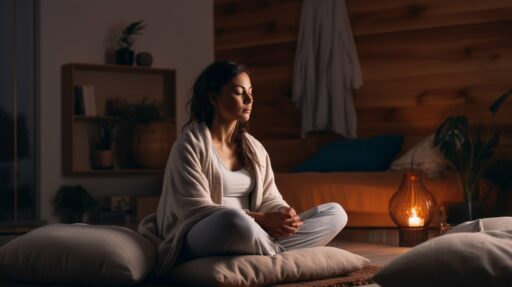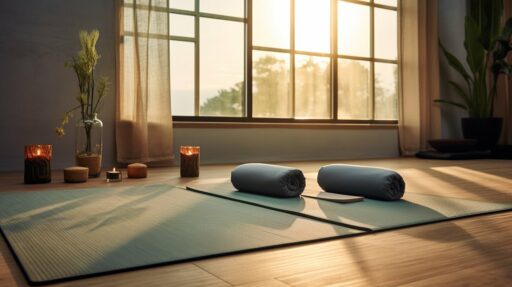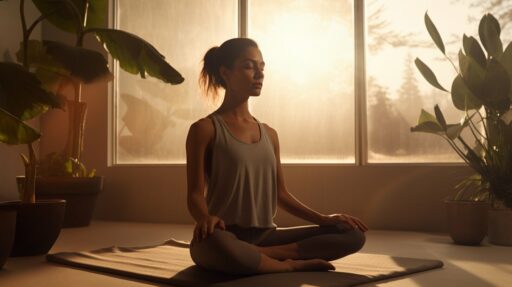Restorative Yoga

Restorative yoga is a style of yoga that offers numerous benefits for your physical, mental, and emotional well-being. By incorporating restorative yoga into your wellness routine, you can experience deep relaxation and find balance amidst the challenges of modern life.
Restorative yoga involves slow-paced, gentle poses held for an extended period of time. It activates the parasympathetic nervous system, allowing your body to rest, heal, and restore balance. With the use of props such as blocks and blankets, you can find comfortable support in various poses.
The benefits of restorative yoga are abundant. It helps with relaxation, stress reduction, improved mood, pain relief, better sleep, enhanced well-being, and it is a safe practice for individuals with chronic health conditions or during pregnancy.
Key Takeaways:
- Restorative yoga promotes physical, mental, and emotional relaxation.
- It activates the parasympathetic nervous system, allowing the body to rest and heal.
- The use of props provides comfortable support in poses.
- Restorative yoga offers a wide range of benefits, including stress reduction and improved sleep.
- It is a safe practice for individuals with chronic health conditions or during pregnancy.
What is Restorative Yoga?
Restorative yoga is a practice of passive healing and relaxation that focuses on activating the parasympathetic nervous system, promoting rest and digestion. It is a style of yoga that utilizes longer asanas and deep breathing to elicit the relaxation response in the body. Restorative yoga poses are typically held for an extended period of time, allowing the body to fully relax and release tension. This practice is known for its gentle and therapeutic nature, making it suitable for all levels of practitioners.
Restorative yoga often incorporates the use of props such as blocks, bolsters, blankets, and straps to support the body in each pose, ensuring a comfortable and restful experience. Props provide stability and allow practitioners to fully surrender into the pose, promoting relaxation and deepening the benefits of the practice. These props also help individuals with limited flexibility or injuries to modify poses and find comfort.
Restorative yoga is like a vacation for your body and mind. It allows you to slow down, find stillness, and experience a deep sense of relaxation and rejuvenation. It is a practice of self-care and self-compassion, providing a safe space for healing and restoration.
Restorative yoga is not just about physical relaxation; it also nurtures mental and emotional well-being. By engaging in restorative yoga, individuals can cultivate a sense of inner peace, reduce stress and anxiety, and promote overall balance and harmony in their lives. Whether you are a beginner or an experienced yogi, restorative yoga offers a gentle and transformative journey towards holistic wellness.

Benefits of Restorative Yoga
Restorative yoga offers numerous benefits supported by scientific research. Its gentle and therapeutic nature helps relax the mind and body, reducing stress, anxiety, and cortisol levels. By soothing the nervous system, restorative yoga activates the relaxation response, shifting it from the fight-or-flight mode to a state of calm and balance. This practice enhances mood, relieves chronic pain, improves sleep quality, and promotes overall well-being.
One of the key advantages of restorative yoga is its accessibility to individuals with acute or chronic injuries. It provides a safe and gentle approach to finding peace and tranquility amidst the demands of modern life. Restorative yoga can also be incorporated into a comprehensive treatment plan for chronic health conditions, offering therapeutic benefits to individuals with a range of health concerns. Additionally, restorative yoga is considered safe during pregnancy, providing expectant mothers with a practice that supports relaxation and self-care.
When practiced regularly, restorative yoga can help individuals cultivate a deep sense of relaxation, better manage stress, and increase their overall resilience. By offering a space for deep relaxation and stillness, restorative yoga allows the body and mind to release tension and find balance. It promotes a state of calm and serenity, counteracting the fast-paced, stressed-out nature of modern life. Start your journey of self-care and relaxation with restorative yoga today and experience its many benefits for yourself.

The Benefits of Restorative Yoga:
| Benefits | Description |
|---|---|
| Relaxation | Restorative yoga helps relax the mind and body, reducing stress and anxiety levels. |
| Pain Relief | By releasing tension and enhancing circulation, restorative yoga can provide relief from chronic pain. |
| Improved Sleep | The practice of restorative yoga promotes better sleep quality and helps individuals achieve a state of deep relaxation before bedtime. |
| Enhanced Well-being | Regular practice of restorative yoga can improve overall well-being, leading to increased resilience and a greater sense of inner peace. |
Restorative Yoga Poses
Restorative yoga utilizes various poses, often with the support of props like bolsters and blankets. These poses help release tension, stretch the body, promote relaxation, and open up different areas, such as the spine, hips, and shoulders. Poses are typically held for a minimum of 5 minutes, and longer if comfortable. Restorative yoga poses can be modified to accommodate different levels of flexibility and experience.
The Fish Pose
The Fish Pose, also known as Matsyasana, is a gentle backbend that opens up the chest, shoulders, and throat. To practice this pose, lie on your back with your legs extended and bring your hands underneath your hips. Lift your chest and arch your back, supporting your weight with your elbows and forearms. Breathe deeply and relax into the pose for a few minutes.
Child’s Pose
Child’s Pose, or Balasana, is a restful pose that helps release tension in the back, neck, and shoulders. Start by kneeling on the floor and bring your big toes together while keeping your knees hip-width apart. Sit back on your heels and slowly lower your forehead to the mat. Extend your arms forward or place them alongside your body, palms up. Relax and breathe deeply as you rest in this pose.
Corpse Pose
Corpse Pose, or Savasana, is a deeply relaxing pose that allows the body and mind to fully let go. Lie on your back with your legs extended and arms relaxed by your sides, palms facing up. Close your eyes and focus on your breath as you consciously release tension from your body. Stay in this pose for several minutes, allowing yourself to rest and rejuvenate.
Legs-up-the-wall Pose
Legs-up-the-wall Pose, or Viparita Karani, is a gentle inversion that helps improve circulation and relieve fatigue. Lie on your back with your hips close to a wall and extend your legs up the wall. Rest your arms by your sides or place your hands on your belly. Relax and breathe deeply as you let gravity assist in the release of tension from your legs and lower back.

The Essence of Restorative Yoga
Restorative yoga is about deep relaxation and conscious stillness. It encourages a yin approach, focusing on softening and releasing, rather than forcing or striving. The practice helps cultivate the skill of conscious relaxation and allows for the release of unnecessary tension in the body and mind.
Through restorative yoga, one can discover where tension is held, create space for change, and balance the nervous system. By facilitating the relaxation response, restorative yoga counteracts the fast-paced, stressed-out nature of modern life.
The Power of Conscious Relaxation
Restorative yoga offers a sanctuary of calm amidst the chaos of daily life. By intentionally slowing down and surrendering to stillness, you create an opportunity to reconnect with your body, mind, and spirit. This practice promotes a state of deep relaxation, allowing your nervous system to shift from “fight-or-flight” mode to “rest-and-digest” mode.
Through restorative yoga, you can tap into your body’s natural healing capabilities, reduce stress and anxiety, and cultivate a sense of inner peace. By letting go of tension and embracing rest, you give yourself the gift of self-care and rejuvenation.
| Benefits of Restorative Yoga | Restorative Yoga Poses |
|---|---|
|
|
|
|

Restorative yoga is a practice of self-discovery and self-care. It invites you to slow down, tune into your body, and listen to its needs. Through the gentle and supported poses, you can unlock the healing power of relaxation and cultivate a sense of balance and well-being in your life.
Whether you’re looking to reduce stress, improve sleep quality, or simply give yourself permission to rest, restorative yoga offers a nurturing space for you to find solace and stillness. Embrace the essence of restorative yoga and let it guide you on a journey of self-discovery and transformation.
The Advanced Nature of Restorative Yoga
Restorative yoga is often misconceived as an easy recovery practice, but in reality, it is an advanced form of yoga that goes beyond physical healing. This practice delves deep into the realms of relaxation and self-care, offering a pathway to personal growth and healing. Contrary to its gentle and therapeutic nature, restorative yoga requires a willingness to face discomfort and deep emotions.
Restorative yoga is accessible to beginners and individuals with limited mobility or fitness levels. It can be modified to accommodate those with anxiety or chronic illnesses. The practice cultivates the ability to consciously relax and let go of unnecessary tension, allowing for a profound connection with oneself. By embracing restorative yoga, you embark on a journey of self-compassion and self-discovery.
Restorative yoga provides a safe space to explore your inner landscape and navigate the complexities of life. It is not just about physical flexibility and strength, but also about cultivating compassion and understanding. Through the practice of restorative yoga, you can unlock your true potential and find solace amidst the demands of modern life. It is a practice that invites you to slow down, listen to your body, and honor your unique needs and boundaries.

The Advanced Nature of Restorative Yoga
Restorative yoga is often misconceived as an easy recovery practice, but in reality, it is an advanced form of yoga that goes beyond physical healing. This practice delves deep into the realms of relaxation and self-care, offering a pathway to personal growth and healing. Contrary to its gentle and therapeutic nature, restorative yoga requires a willingness to face discomfort and deep emotions.
Restorative yoga is accessible to beginners and individuals with limited mobility or fitness levels. It can be modified to accommodate those with anxiety or chronic illnesses. The practice cultivates the ability to consciously relax and let go of unnecessary tension, allowing for a profound connection with oneself. By embracing restorative yoga, you embark on a journey of self-compassion and self-discovery.
| Key Points | Benefits |
|---|---|
| Access to all levels | Allows beginners to practice |
| Modified poses | Accommodates anxiety and chronic illnesses |
| Conscious relaxation | Cultivates self-compassion and self-discovery |
Restorative yoga provides a safe space to explore your inner landscape and navigate the complexities of life. It is not just about physical flexibility and strength, but also about cultivating compassion and understanding. Through the practice of restorative yoga, you can unlock your true potential and find solace amidst the demands of modern life. It is a practice that invites you to slow down, listen to your body, and honor your unique needs and boundaries.
Restorative Yoga: Cultivating Compassion and Understanding
Restorative yoga offers an opportunity to connect with our natural qualities of compassion and understanding. By engaging in this practice, you can create a space for deep relaxation and introspection, allowing yourself to let go of the stresses and tensions of everyday life. As you soften your body and mind, you can rest in your true nature, recognizing your interconnectedness with the world around you. Restorative yoga encourages a shift from constant doing and striving to experiencing the present moment with a sense of acceptance and serenity.
Restorative yoga is also known for its ability to promote better sleep. By practicing restorative yoga, you can calm your mind and release physical tension, setting the stage for a peaceful and restful night’s sleep. This practice cultivates a state of calm and relaxation, helping you let go of the worries and distractions that can often keep you awake at night. As you surrender to the gentle movements and supported poses of restorative yoga, you can find solace in the stillness and embrace the tranquility that sleep brings.
| Benefits of Restorative Yoga | Why Restorative Yoga for Sleep? |
|---|---|
|
|
Restorative yoga is not just about physical recovery; it is an advanced practice that offers profound healing on multiple levels. By embracing the power of relaxation and self-care, you can unlock your true potential and embark on a journey of personal growth and transformation. Restorative yoga invites you to let go of unnecessary tension and cultivate compassion and understanding for yourself and others. It is a practice of deep rest and introspection, guiding you to discover the stillness and serenity that reside within.
As you delve deeper into the practice of restorative yoga, you will find that it has the ability to heal stress-related physical and emotional issues. By activating the relaxation response, restorative yoga counteracts the effects of chronic stress, promoting overall well-being and resilience. This gentle and nurturing practice can be particularly beneficial for individuals experiencing stress, anxiety, and related disorders. It offers a safe space to find peace and tranquility amidst the demands of modern life, allowing you to reconnect with your true essence and embrace a path of healing and self-discovery.
Incorporating restorative yoga into your daily routine can be a transformative experience. Whether you are a beginner or have been practicing for years, restorative yoga offers a nurturing and supportive approach to self-care. By prioritizing relaxation and stillness, you can tap into your inner wisdom and unlock your true potential. Start your journey of cultivating compassion and understanding with restorative yoga today, and discover the profound benefits it can bring to all aspects of your life.

The Healing Power of Restorative Yoga
Restorative yoga holds immense healing potential, offering a sanctuary for the mind and body to release stress and find balance. This gentle practice provides a safe and nurturing environment for individuals seeking relief from stress and anxiety. By activating the relaxation response, restorative yoga allows the body’s natural healing mechanisms to kick in, promoting overall well-being and tranquility.
Through the use of supported poses and props, restorative yoga encourages deep relaxation and rejuvenation. As you surrender into each pose, tension and stress melt away, making room for a profound sense of calm and peace. This practice can be particularly beneficial for those experiencing stress-related physical and emotional issues, as it helps to reduce cortisol levels and restore harmony in the body.
“Restorative yoga is like pressing the reset button for your mind and body. It allows you to pause, breathe, and replenish your energy. The stillness and support offered in each pose provide an opportunity for deep healing and self-care.”
Restorative yoga also promotes self-compassion and self-awareness. By cultivating a mindset of non-judgment and acceptance, you allow yourself to fully explore the depths of your being. This practice is not just about physical flexibility; it’s about embracing relaxation as a vital aspect of your overall well-being. Whether you’re a beginner or an experienced yogi, restorative yoga offers a path to self-discovery, healing, and personal growth.

Restorative Yoga Poses for Stress Relief
To help you experience the healing power of restorative yoga, here are some poses that are particularly beneficial for stress relief:
| Poses | Description |
|---|---|
| Child’s Pose (Balasana) | A gentle forward fold that promotes relaxation and releases tension in the back and hips. |
| Legs-up-the-Wall Pose (Viparita Karani) | A restful inversion that helps improve circulation and alleviate fatigue and anxiety. |
| Supported Bridge Pose (Setu Bandha Sarvangasana) | A heart-opening pose that relieves stress and calms the nervous system. |
| Corpse Pose (Savasana) | A deeply relaxing pose that allows for complete surrender and rejuvenation. |
Remember to listen to your body and modify the poses as needed. Create a peaceful and comfortable space for your restorative yoga practice, using props such as bolsters, blankets, and blocks to support your body and enhance relaxation. With regular practice, you’ll discover the profound benefits of restorative yoga and find solace in the healing power of deep relaxation.
Unlocking the True Potential of Restorative Yoga
Restorative yoga is not only a practice for experienced yogis but also a welcoming journey for beginners. Regardless of your fitness level or mobility, restorative yoga offers a space for self-compassion and self-care. It is a practice that allows you to listen to your body and honor your unique needs and boundaries.
Embracing the power of relaxation and stillness, restorative yoga goes beyond physical flexibility and strength. It invites you to explore the depths of your being and connect with your inner wisdom. By creating a safe and nurturing environment, restorative yoga unlocks your true potential, encouraging personal growth and healing.
Whether you are new to yoga or have limited experience, restorative yoga provides a gentle and accessible path to finding peace and tranquility. With the support of props and extended holds in each pose, restorative yoga allows you to fully relax and surrender. It is a practice of self-discovery and self-acceptance, guiding you towards a state of deep relaxation and facilitating holistic well-being.

| Benefits of Restorative Yoga for Beginners | How to Get Started |
|---|---|
|
|
By starting your restorative yoga journey as a beginner, you have the opportunity to cultivate self-awareness, relieve stress, and enhance your overall well-being. Take a step towards unlocking your true potential with restorative yoga today.
The Journey to Stillness: Restorative Yoga as a Path
Restorative yoga offers a profound experience of rest and introspection, taking you on a journey to stillness. It is a practice that allows you to let go of the constant striving and busyness of life, and instead, embrace the simplicity and peace that comes with being present. Through restorative yoga, you can find solace in quietude and reconnect with your true nature.
One of the benefits of restorative yoga is its ability to promote a state of calm and relaxation, making it a practice that can be particularly beneficial for sleep. By calming the mind and preparing the body for restful sleep, restorative yoga can help improve sleep quality and promote a sense of rejuvenation upon waking. So if you find yourself struggling with sleep, incorporating restorative yoga into your bedtime routine may offer the serenity you seek.

In the journey to stillness through restorative yoga, you will learn to slow down and listen to your body. This practice is all about creating space for deep relaxation and self-care. It invites you to unlock your true potential by embracing the power of conscious rest and letting go of unnecessary tension. Restorative yoga is not just a physical practice; it is a path towards self-discovery and healing.
Through the practice of restorative yoga, you can rediscover your true essence and connect with the depths of your being. It cultivates qualities of compassion and understanding, allowing you to rest in your true nature and embrace acceptance of life as it is. By incorporating restorative yoga into your wellness regimen, you can find balance amidst the challenges of modern life and enhance your overall well-being.
Conclusion
Restorative yoga is a powerful practice that offers a multitude of benefits for your physical, mental, and emotional well-being. By incorporating restorative yoga into your wellness routine, you can experience deep relaxation and find respite from the stresses of daily life. Whether you’re a beginner or have chronic health conditions, restorative yoga is accessible to individuals of all levels.
Through the practice of restorative yoga, you can cultivate a sense of calm and relaxation, reducing stress and promoting overall resilience. This gentle and therapeutic practice allows you to release tension, improve sleep quality, and enhance your overall sense of well-being. By dedicating time to self-care and relaxation, you can unlock the true potential of restorative yoga and discover the transformative power it holds.
So why wait? Start your journey of self-care and relaxation with restorative yoga today. Embrace the practice, let go of unnecessary tension, and find balance and tranquility. Experience the multitude of benefits that restorative yoga has to offer and enhance your quality of life. Discover why restorative yoga is essential for your well-being and embrace the path to relaxation and self-discovery.
FAQ
What is restorative yoga?
Restorative yoga is a style of yoga that encourages physical, mental, and emotional relaxation through slow-paced, gentle poses held for an extended period of time.
How does restorative yoga activate the parasympathetic nervous system?
Restorative yoga activates the parasympathetic nervous system by creating a state of deep relaxation, allowing the body to rest, heal, and restore balance.
What props are commonly used in restorative yoga?
Props such as blocks and blankets are commonly used in restorative yoga to provide comfortable support in poses.
What are the benefits of restorative yoga?
The benefits of restorative yoga include relaxation, stress reduction, improved mood, pain relief, better sleep, enhanced well-being, and safe practice for those with chronic health conditions or during pregnancy.
What are some common restorative yoga poses?
Common restorative yoga poses include the Fish Pose, Child’s Pose, Corpse Pose, and Legs-up-the-wall Pose, which help release tension, stretch the body, and promote relaxation.
Is restorative yoga suitable for beginners?
Yes, restorative yoga can be practiced by beginners and modified to accommodate different levels of flexibility and experience.
Can restorative yoga be practiced by individuals with chronic health conditions?
Yes, restorative yoga is considered safe for individuals with chronic health conditions and can be part of a comprehensive treatment plan.
Is restorative yoga safe during pregnancy?
Yes, restorative yoga is considered safe during pregnancy and can provide relaxation and support for expectant mothers.
Is restorative yoga only for physical recovery?
No, restorative yoga goes beyond physical recovery and is an advanced practice that helps cultivate conscious relaxation, personal growth, and healing.
How does restorative yoga help improve sleep quality?
Restorative yoga promotes a state of calm and relaxation, helping calm the mind and prepare the body for restful sleep.
How does restorative yoga counteract the effects of chronic stress?
Restorative yoga activates the relaxation response, shifting the nervous system from the fight-or-flight response to a state of relaxation and balance, reducing the effects of chronic stress.
Can restorative yoga be practiced by individuals with anxiety?
Yes, restorative yoga can be beneficial for individuals with anxiety as it promotes relaxation, reduces stress, and cultivates a sense of calm.
How does restorative yoga cultivate compassion and understanding?
Restorative yoga encourages softening and releasing, allowing us to connect with our natural qualities of compassion and understanding, and recognize our interconnectedness.
Can restorative yoga help with stress-related physical and emotional issues?
Yes, restorative yoga can help heal stress-related physical and emotional issues by creating a space for deep relaxation, tension release, and balance.
Is restorative yoga accessible to individuals with limited mobility or fitness levels?
Yes, restorative yoga can be practiced by individuals with limited mobility or fitness levels and is a practice of self-compassion and honoring individual needs.
How does restorative yoga help us find stillness and peace?
Restorative yoga encourages slowing down, listening to our bodies, and finding solace in quietude, allowing us to connect with our true nature and experience the present moment with acceptance and serenity.
How does restorative yoga enhance overall well-being?
Restorative yoga promotes relaxation, stress relief, improved sleep, pain reduction, and overall resilience, leading to enhanced overall well-being.
Why is restorative yoga essential for personal growth?
Restorative yoga requires a willingness to face discomfort and deep feelings, making it an essential practice for personal growth, healing, and self-care.
How can restorative yoga unlock our true potential?
Restorative yoga invites us to explore the depths of our being and connect with our inner wisdom, allowing us to unlock our true potential through relaxation and self-care.
Restorative Yoga
Here are a few comprehensive and authoritative websites related to Restorative Yoga that you might find helpful:
- Ekhart Yoga: Offers a wide range of restorative yoga classes, articles, and resources to help balance busy lifestyles and heal stress-related physical and emotional issues. The site emphasizes the healing power of Restorative Yoga, utilizing props like bolsters, blankets, and blocks to fully support the body in poses, encouraging relaxation and the activation of the parasympathetic nervous system. For more detailed guidance and programs, visit Ekhart Yoga at https://www.ekhartyoga.com/articles/practice/why-restorative-yoga.
- YogaWorks: This platform offers online Restorative Yoga classes that focus on slow, long-held movements and deep breathing to encourage total physical and emotional relaxation. Classes aim to decrease stress and anxiety, enhance mental and emotional relaxation, and provide a greater sense of tranquility. To explore their Restorative Yoga classes and start a free trial, visit YogaWorks at https://www.yogaworks.com.
These websites provide a great starting point for engaging with Restorative Yoga, whether you’re looking to deepen your practice or just starting out. They offer various resources, including free trials, detailed class descriptions, and benefits of Restorative Yoga, to help you find relaxation and balance.
